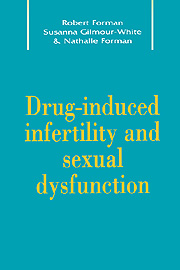Preface
Published online by Cambridge University Press: 30 March 2010
Summary
The idea for this book originated from the professional frustration experienced by the authors in the face of apparently simple enquiries from patients or health care colleagues. Questions on the possibility that patients’ fertility or sexual problems could be drug related resulted in extensive literature searches, discussions with pharmaceutical companies and, sometimes, contact with the Committee on Safety of Medicines. These endeavours generated a collection of academic papers requiring time-consuming analysis before a reply could be given.
The desirability for a comprehensive reference text which included much of this information in a readily accessible form was all too evident.
One of the difficulties in a project of this type is the source of data. We were only able to access information in the public domain. Two important sources of valuable data are not available to the public. These are the databases collated by the Committee on Safety of Medicines via the yellow card notification scheme and those held by pharmaceutical manufacturers. Manufacturers have a reporting obligation to notify the Committee on Safety of Medicines about serious or life-threatening adverse effects. Infertility and sexual dysfunction do not come into this category.
Academic journals are the major reference source for much of the information in this book. Adverse drug effects may be published as case reports, which can be useful early warnings of a potential problem but do not necessarily represent general experience. Controlled clinical trials of adverse reproductive effects are few and far between but have been included where available. Many drugs are given for diseases which can themselves affect reproductive function and this is highlighted in the relevant sections.
- Type
- Chapter
- Information
- Drug-Induced Infertility and Sexual Dysfunction , pp. ix - xPublisher: Cambridge University PressPrint publication year: 1996



